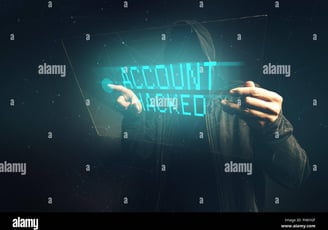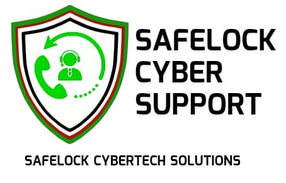SAFELOCK CYBER SUPPORT
Hacked Online Bank Account
Use this guide when someone has accessed your online bank account without your authorization. If your online bank account has been hacked or you notice unauthorized transactions, acting quickly is essential to protect your finances and identity. Indian laws provide specific protections and remed02ies for such situations. Here's what to do:
Cyber criminals are typically financially motivated and getting access to an online bank account is the crown jewels for many. If you have noticed suspicious transactions or activity on your online bank account you need to act quickly to limit the damage the perpetrator can do.
We want to better understand the impact of you experiencing this issue, can you share your experience by filling in this online form? This will help us better protect future victims.
Hacked online bank account - Do this first!
Contact Your Bank Immediately
Call your bank’s customer care number or visit the nearest branch as soon as you detect suspicious activity.
Use the official contact information from your bank statement, card, or website.
If money has been stolen, the bank will secure your account and prevent further unauthorized transactions.
Example: If ₹10,000 was withdrawn without your consent, report it immediately. The bank will freeze the account, investigate, and potentially refund the amount based on their findings.
Change Your Login Details
If you still have access to your account, reset your password and security details immediately to block unauthorized access.
Mitigation: Use a strong password, such as “Jh@27#U9z%!” instead of a simple one like “123456”.
File a Report with Cybercrime Authorities
Report the incident to India’s National Cyber Crime Reporting Portal: https://cybercrime.gov.in.
Alternatively, call the Cybercrime Helpline Number 1930.
Example: If the hacker used your account to make purchases, this report ensures the incident is logged, which can help in legal or insurance claims.
Understanding Your Refund Rights
Will I Get My Money Back?
Yes: Banks in India are required by RBI guidelines to refund amounts lost due to unauthorized transactions if reported promptly.
No: If you were tricked into transferring money or negligently shared your credentials, the bank may deny the refund.
Mitigation: Avoid sharing OTPs or account credentials with anyone, even if they claim to be from the bank.
For more information, refer to:
RBI Guidelines on Unauthorized Transactions: https://www.rbi.org.in.
Additional Steps
1. Review Account Activity
Check recent transactions, payees, and direct debits for unauthorized changes.
Example: If you find a new payee added without your permission, inform the bank and request removal.
2. Check Security Logs
Review the account’s activity logs for suspicious logins or devices connected to your account.
Example: If you notice a login from an unfamiliar location (e.g., “Login from Moscow, Russia”), flag it with your bank immediately.
3. Scan Your Devices for Malware
Use trusted antivirus solutions to detect and remove malware from devices you use to access your bank account.
Mitigation: Regularly update your antivirus software and avoid downloading unknown files or software.
4. Monitor Financial Activities
Regularly check your bank account for any suspicious activity.
Example: If your credit report shows a loan you didn’t apply for, notify the credit bureau and relevant authorities.
Useful resources:
CIBIL (TransUnion): https://www.cibil.com.
Experian India: https://www.experian.in.
Equifax India: https://www.equifax.co.in.
Preventing Future Hacks
1. Secure Your Banking Details
Keep financial documents and cards safe.
Destroy old cards and unused documents securely.
Example: Use a cross-cut shredder for disposing of sensitive documents.
2. Use Official Channels Only
Access your bank account by typing the official website address directly into your browser.
Example: Avoid links in emails like “Click here to log in to your bank,” which could lead to phishing websites.
3. Strengthen Password Practices
Use strong, unique passwords for every account.
Example: Instead of using “password123,” opt for something like “B@nK!84#Secure.”
Resource: Password tips at https://www.cyberswachhtakendra.gov.in.
4. Enable Two-Factor Authentication (2FA)
Activate 2FA on your banking and other critical online accounts for added security.
Example: Use an authenticator app like Google Authenticator instead of SMS-based OTPs, which can be intercepted.
5. Stay Alert Against Phishing
Learn to identify phishing attempts.
Example: Avoid emails claiming, “Your account is locked! Click here to unlock,” unless verified.
Guidance: https://www.cert-in.org.in.
6. Educate Yourself on Cybersecurity
Improve your knowledge of cybersecurity best practices.
Resources:
Cyber Swachhta Kendra: https://www.cyberswachhtakendra.gov.in.
CERT-In (Indian Computer Emergency Response Team): https://www.cert-in.org.in.
Digital India Cyber Awareness: https://www.digitalindia.gov.in.
By acting quickly, using these resources, and following the examples and mitigation strategies, you can recover from a hacked account and prevent future breaches.
Relevant Laws for Online Banking Fraud
Information Technology Act, 2000:
Section 43: Penalty for unauthorized access to a computer system.
Section 66: Punishment for identity theft and hacking.
Section 66C: Punishment for identity theft (up to 3 years imprisonment and/or fine).
Section 66D: Punishment for cheating by impersonation through electronic means.
Indian Penal Code (IPC):
Section 378: Theft.
Section 420: Cheating and dishonestly inducing delivery of property.
Section 468: Forgery for the purpose of cheating.
Consumer Protection Act, 2019:
Protects customers against deficiency of service by banks.
How do I avoid my bank account being hacked in future?
There are a number of ways you can reduce the risk of bank fraud:
Keep your cards and financial details safe - try and keep your card in sight when making a transaction. Sign new cards as soon as they arrive and destroy old cards by cutting through the magnetic strip and chip. Keep your financial documents safe and use a shredder to destroy them when you don’t need them anymore.
Secure your PIN - memorize your PIN and destroy the letter sent to tell you your PIN. Make sure you are the only person who knows your PIN and make sure nobody can see you enter it at ATMs. Set your pin to something random and avoid things like your date of birth.
Only visit your online bank account by typing in the address into your web browser - never follow a link in a text or email.
Get good at passwords - use strong passwords, use different passwords on each site, never share them and change them regularly. Use a password manager app to help you do this. See some good guidance here.
Commit to two-factor authentication - two-factor is a way to improve your security drastically in one easy step. Use it on every site that offers it. You can get more information here.
Review account security settings - all social media accounts offer a range of security features such as log in notification, secure browsing and two-factor authentication. Review these settings and turn all security options on.
Be careful clicking or downloading - tricking you to share your password by sending you trick emails or texts is a really common way to have your passwords stolen. As is downloading attachments in email that contain malicious software. Be extremely careful when clicking online links or opening/downloading online attachments.
Get secure - take time to improve your general online security. Use sites like Get Safe Online and Cyber Aware to understand what good security looks like and make changes.
For more information visit - safelocktech.com
Our architecture services take into consideration your lifestyle and preferences to create spaces that are both beautiful and functional.


